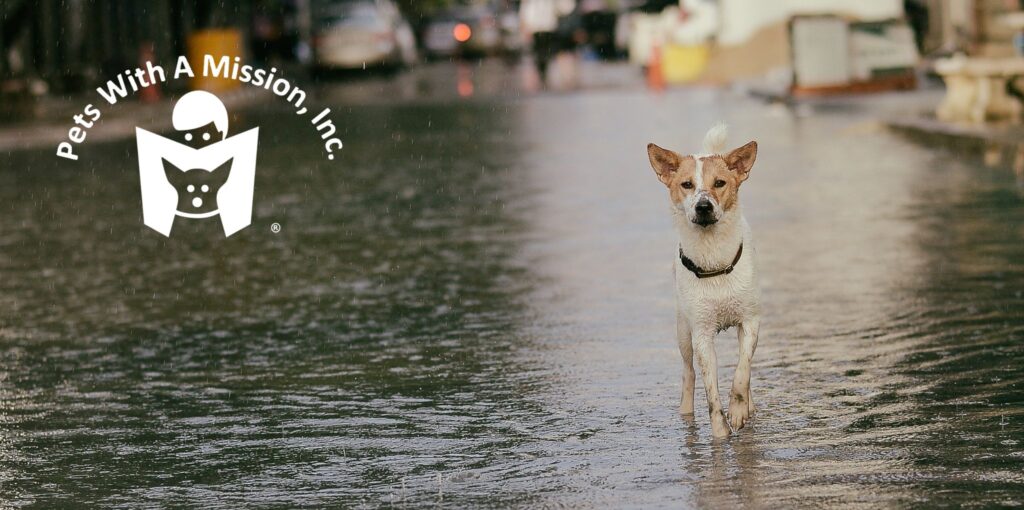Pets with A Mission, Inc.: Katrina, Pets and the Aftermath
For a bit of background, Katrina was a hurricane that made landfall in Florida in late August 2005, crossed the peninsula, and entered the Gulf of Mexico. All the gulf coast states were on alert but Louisiana, 45 miles south east of New Orleans, was the unlucky recipient of the second landfall of the category 3 storm. While wind and tornados were obvious threats, the biggest concern became water.
New Orleans has unique topography. The city is on the banks of the Mississippi River with Lake Pontchartrain, Lake Borgne and swampland encircling the city. New Orleans is below sea level in a bowl-shaped area. The city relies on a levy system and pumps to remain dry. The 10 inches of rain plus a 26-foot storm surge caused water to spill over the top of some levees and broke through other levees. Water overran 80% of the city with some areas under water 20 feet deep.
In late August 2005, the city of just under 500,000 people was told to evacuate in advance of Hurricane Katrina. That created a problem because an estimated 112,000 people did not have vehicles. The city provided busses to take people out of the area and opened shelters for those who stayed in the city. The disaster preparedness staff who planned for those activities did not include plans for the transport or care of the animals of New Orleans. The lack of plans for animals was intentional because they did not consider animals to be important. That failure came back to bite them big time as their failures were broadcast nightly on national news programs.
It is estimated that 80 percent of the population evacuated. Many of those people left their pets locked up in back yards are inside the house. They left food and water to last for two or three days because they thought they would be back by then. About 10,000 people went to the Superdome shelter seeking safety. Upon arrival, they found that the shelter would not accept pets. In addition, the busses provided for evacuations would not take pets either. The people faced the agonizing decision of abandoning their pets for their own safety or returning home with their pets to ride out the storm. Many people chose to return home. There were some cases were people were forcibly separated from their pets by local officials. One such case was told on national news: a small boy tried to board a bus with his small white dog named Snowball. The dog was removed from his arms by a bus monitor as the boy cried uncontrollably. The boy and Snowball became the poster child with dog for the callous government ineptitude that made a bad situation worse.
For the people who remained at home with their pets, conditions continued to deteriorate. The waters kept rising flooding houses and neighborhoods. Many people and pets moved upstairs, sometime into attics or on roofs to escape the flood. In time, people were rescued by dump trucks, boats or helicopters, but again, most of the time pets were not allowed on the rescue vehicles. A few kind individuals turned a blind eye and let pets onboard in some isolated instances.
Individuals stepped in to rescue the thousands of pets left behind. The volunteers went out in trucks and boats. They had some addresses where pets were but the flood waters hid road signs and changed the landscape. It made finding specific homes almost impossible. Volunteers checked porches and yards and looked in windows to find pets. Then they broke in to rescue the animals. A temporary shelter was set up at the Lamar-Dixon Expo Center in Gonzales, 60 miles away. People from 40 different rescue groups rescued animals and cared for them. Pets were driven or flown out of the area to other rescue groups to free up spaces for more animals from the New Orleans area. Through the volunteer’s efforts, about 15,500 animals were rescued but less than 20 percent were reunited with their families. Unfortunately, another 50,000 to 70,000 did not survive the aftermath of Hurricane Katrina. It was a horrible and unnecessary tragedy.
The failures of governmental responses, human and animal, to Katrina played out on nightly news programs to homes across America. People inundated local and federal lawmakers about the deplorable treatment of animals. As a result, the U. S. Congress passed The Pet Evacuation and Transportation Standards (PETS) Act of 2006 (42 U.S.C.A. §5196-5196d).
The Act requires FEMA and states who receive FEMA funds to have disaster plans that include the transportation and care of pets along with the people. Pets must be housed in a separate area of the people shelter or put up in a nearby facility designated as a pet shelter. The PETS Act only applies to service animals and household pets who are cats, dogs, birds, rabbits, and turtles. It excludes fish, farm animals, and reptiles. Zoo animals are covered by a different act. Legislatures in more than 30 states have passed similar laws related to the transportation and sheltering of household pets during evacuations. The PETS Act provides significant improvements for many pets at times of disasters. But there is a way to go to provide for the care of all the animals that were excluded from the Act.
Hurricane Katrina and its aftermath was broadcast on the news for the whole country to see. People evacuated but they left their pets behind. Other people took their pets with them but were denied transportation or shelter for the animals. People saw pets ripped away from their families by callous officials. Later, they saw the heart-warming efforts of volunteers who rescued pets left behind when their families evacuated. Katrina served as a learning experience for everyone and directly led to passage of The PETS Act and similar legislation at the state level.
